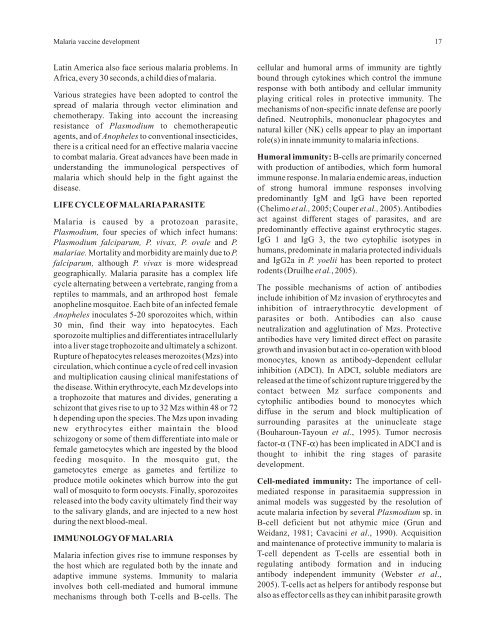PDF File - The Indian Society for Parasitology
PDF File - The Indian Society for Parasitology
PDF File - The Indian Society for Parasitology
Create successful ePaper yourself
Turn your PDF publications into a flip-book with our unique Google optimized e-Paper software.
Malaria vaccine development17cellular and humoral arms of immunity are tightlybound through cytokines which control the immuneresponse with both antibody and cellular immunityplaying critical roles in protective immunity. <strong>The</strong>mechanisms of non-specific innate defense are poorlydefined. Neutrophils, mononuclear phagocytes andnatural killer (NK) cells appear to play an importantrole(s) in innate immunity to malaria infections.Humoral immunity: B-cells are primarily concernedwith production of antibodies, which <strong>for</strong>m humoralimmune response. In malaria endemic areas, inductionof strong humoral immune responses involvingpredominantly IgM and IgG have been reported(Chelimo et al., 2005; Couper et al., 2005). Antibodiesact against different stages of parasites, and arepredominantly effective against erythrocytic stages.IgG 1 and IgG 3, the two cytophilic isotypes inhumans, predominate in malaria protected individualsand IgG2a in P. yoelii has been reported to protectrodents (Druilhe et al., 2005).<strong>The</strong> possible mechanisms of action of antibodiesinclude inhibition of Mz invasion of erythrocytes andinhibition of intraerythrocytic development ofparasites or both. Antibodies can also causeneutralization and agglutination of Mzs. Protectiveantibodies have very limited direct effect on parasitegrowth and invasion but act in co-operation with bloodmonocytes, known as antibody-dependent cellularinhibition (ADCI). In ADCI, soluble mediators arereleased at the time of schizont rupture triggered by thecontact between Mz surface components andcytophilic antibodies bound to monocytes whichdiffuse in the serum and block multiplication ofsurrounding parasites at the uninucleate stage(Bouharoun-Tayoun et al., 1995). Tumor necrosisfactor-α (TNF-α) has been implicated in ADCI and isthought to inhibit the ring stages of parasitedevelopment.Cell-mediated immunity: <strong>The</strong> importance of cell-mediated response in parasitaemia suppression inanimal models was suggested by the resolution ofacute malaria infection by several Plasmodium sp. inB-cell deficient but not athymic mice (Grun andWeidanz, 1981; Cavacini et al., 1990). Acquisitionand maintenance of protective immunity to malaria isT-cell dependent as T-cells are essential both inregulating antibody <strong>for</strong>mation and in inducingantibody independent immunity (Webster et al.,2005). T-cells act as helpers <strong>for</strong> antibody response butalso as effector cells as they can inhibit parasite growthLatin America also face serious malaria problems. InAfrica, every 30 seconds, a child dies of malaria.Various strategies have been adopted to control thespread of malaria through vector elimination andchemotherapy. Taking into account the increasingresistance of Plasmodium to chemotherapeuticagents, and of Anopheles to conventional insecticides,there is a critical need <strong>for</strong> an effective malaria vaccineto combat malaria. Great advances have been made inunderstanding the immunological perspectives ofmalaria which should help in the fight against thedisease.LIFE CYCLE OF MALARIA PARASITEMalaria is caused by a protozoan parasite,Plasmodium, four species of which infect humans:Plasmodium falciparum, P. vivax, P. ovale and P.malariae. Mortality and morbidity are mainly due to P.falciparum, although P. vivax is more widespreadgeographically. Malaria parasite has a complex lifecycle alternating between a vertebrate, ranging from areptiles to mammals, and an arthropod host femaleanopheline mosquitoe. Each bite of an infected femaleAnopheles inoculates 5-20 sporozoites which, within30 min, find their way into hepatocytes. Eachsporozoite multiplies and differentiates intracellularlyinto a liver stage trophozoite and ultimately a schizont.Rupture of hepatocytes releases merozoites (Mzs) intocirculation, which continue a cycle of red cell invasionand multiplication causing clinical manifestations ofthe disease. Within erythrocyte, each Mz develops intoa trophozoite that matures and divides, generating aschizont that gives rise to up to 32 Mzs within 48 or 72h depending upon the species. <strong>The</strong> Mzs upon invadingnew erythrocytes either maintain the bloodschizogony or some of them differentiate into male orfemale gametocytes which are ingested by the bloodfeeding mosquito. In the mosquito gut, thegametocytes emerge as gametes and fertilize toproduce motile ookinetes which burrow into the gutwall of mosquito to <strong>for</strong>m oocysts. Finally, sporozoitesreleased into the body cavity ultimately find their wayto the salivary glands, and are injected to a new hostduring the next blood-meal.IMMUNOLOGY OF MALARIAMalaria infection gives rise to immune responses bythe host which are regulated both by the innate andadaptive immune systems. Immunity to malariainvolves both cell-mediated and humoral immunemechanisms through both T-cells and B-cells. <strong>The</strong>










